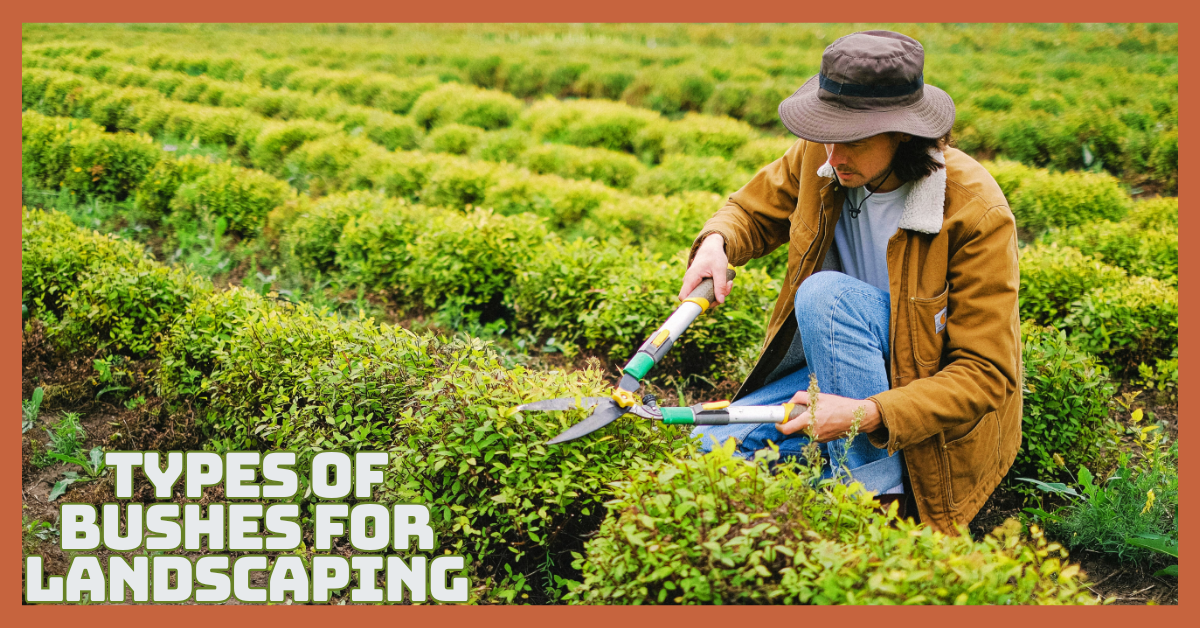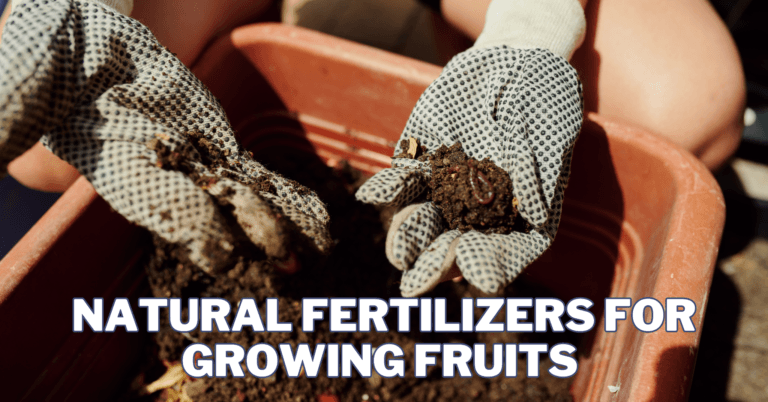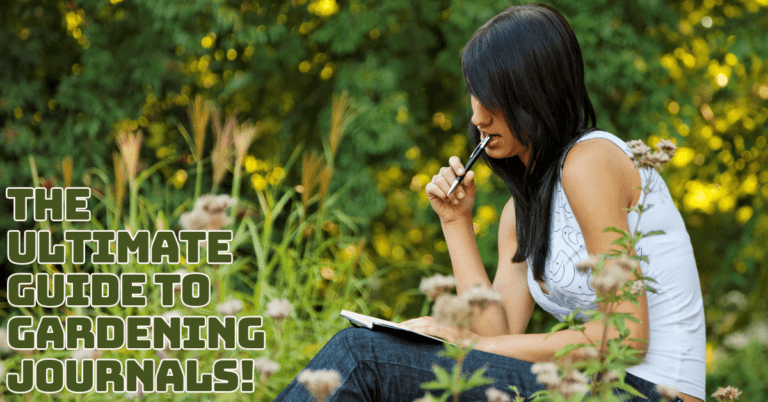Best Types Of Bushes For Landscaping
When it comes to transforming an ordinary outdoor space into a breathtaking landscape, bushes are indispensable. They bring structure, colour, privacy, and texture to gardens, acting as elegant borders, lush fillers, or bold focal points.
Whether you’re designing a formal garden or a relaxed backyard retreat, the right types of bushes can elevate your entire landscape.
In this comprehensive guide, we’ll explore the best types of bushes for landscaping, organized by their purpose, appearance, and maintenance level. From flowering shrubs to evergreen hedges, here’s everything you need to know.
Why Use Shrubs In Landscaping?
Before diving into specific types, it’s essential to understand why shrubs are such a valuable addition to any landscape:
1. Improved Air Quality
Shrubs act like nature’s air filters. They soak up carbon dioxide, trap dust and pollutants, and release fresh oxygen. Planting them around your home doesn’t just look good—it helps you breathe easier every single day.
2. Erosion Control
With strong roots that grip the soil, shrubs are nature’s solution to erosion. They hold the ground in place during rain or wind, keeping valuable nutrients in the soil and preventing slopes from washing away.
3. Energy Efficiency
Well-placed shrubs do more than decorate—they shield your home from scorching sun and chilly winds. Your area will remain comfortable and environmentally friendly with this natural insulation, which can cut your heating and cooling costs by up to 25%.
4. Curb Appeal & Property Value
A thoughtfully landscaped yard filled with healthy shrubs instantly makes your home feel more welcoming. That first impression counts—buyers are more likely to fall in love with your property, potentially boosting its market value.
5. Privacy & Noise Reduction
Tall, leafy shrubs create a natural barrier that gives you peace. They block unwanted views, soften street noise, and turn your outdoor space into a more private, peaceful retreat.
6. Wildlife Habitat
Many shrubs provide food and shelter for birds, butterflies, and helpful insects. By planting them, you’re inviting nature into your yard, turning it into a haven for wildlife and supporting the local ecosystem.
Types Of Bushes For Landscaping: Add Beauty, Privacy, And Value
Landscaping with bushes is one of the simplest ways to transform your outdoor space. Here's a look at the best types of bushes to enhance your landscape with beauty, function, and lasting value.
Evergreen Bushes
Evergreen bushes give your landscape consistent colour and shape because they keep their leaves throughout the year.
1. Boxwood Bushes (Buxus)
Best For
Boxwood is perfect for creating neat, structured lines in your garden. It’s often used in formal landscapes and elegant border designs.
Thanks to its compact growth, it responds well to shaping, making it ideal for hedges, parterres, and even topiary in both small and large spaces.
Appearance
This shrub features tightly packed, glossy green leaves that maintain their colour year-round. Its dense foliage gives it a polished, uniform look that fits beautifully into classic or contemporary landscapes. Boxwood’s evergreen charm ensures your garden looks fresh and vibrant, even in the colder months.
Care
Although they require little maintenance, boxwoods benefit from routine trimming to keep their size and shape. Full sun or mild shade is ideal for them, and they need soil that drains properly.
Occasional watering and seasonal mulching help keep them healthy, while trimming keeps them tidy and beautiful. They flourish in USDA Zones 5 through 9.
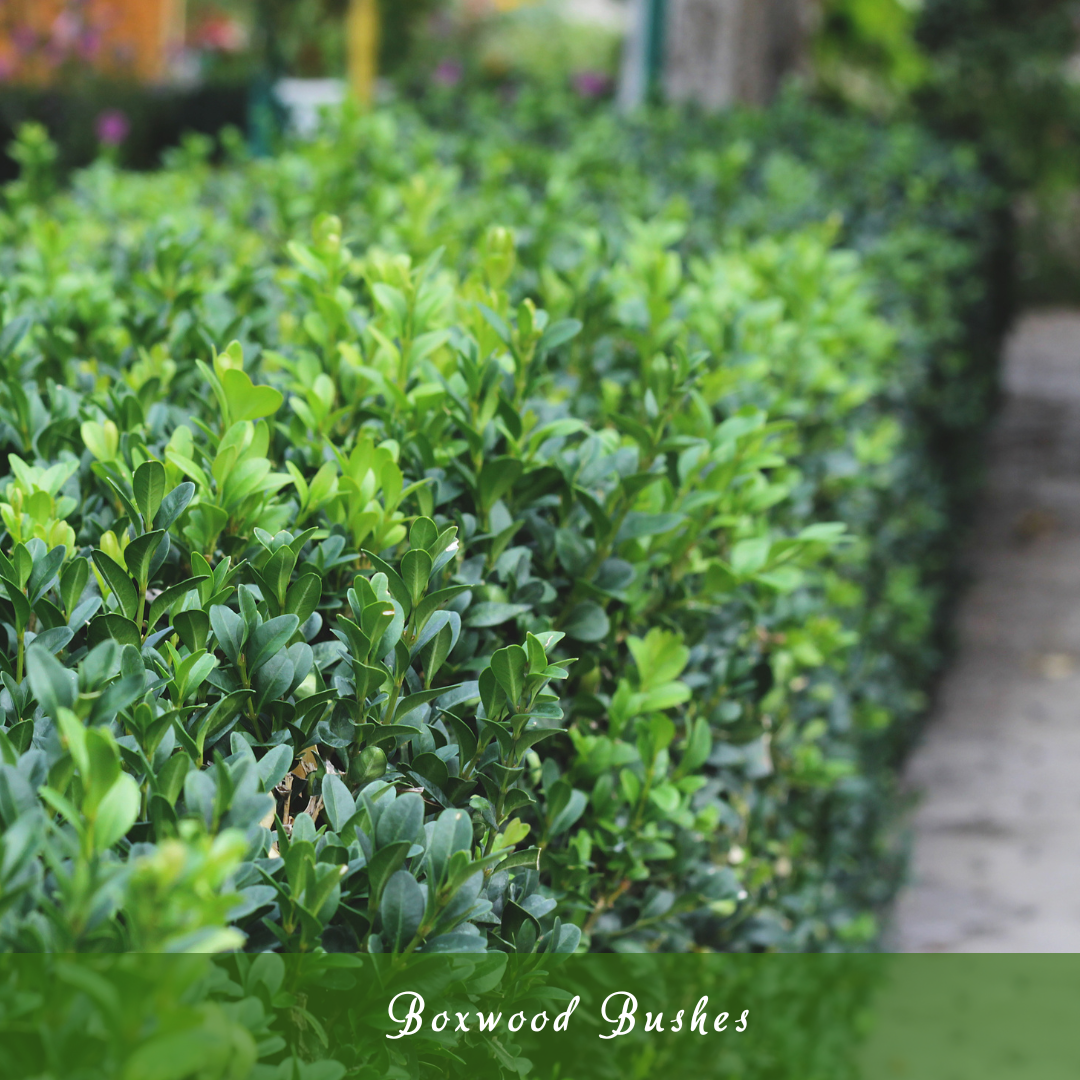
2. Holly Shrubs (Ilex)
Best For
Holly shrubs grow tall and thick, making them excellent for creating natural privacy barriers in your yard. Their festive red berries and deep green leaves also make them a popular choice for holiday decorations, adding seasonal charm to both gardens and indoor arrangements during wintertime.
Appearance
Holly is known for its attractive, shiny green leaves, often edged with spiny tips. Female plants bear vivid red berries in the fall and winter, which contrast with the foliage. This eye-catching combination provides year-round visual interest and serves as a favorite winter accent in gardens.
Care
Once established, holly is a thorny, drought-tolerant shrub that needs little attention. Although it may thrive in moderate shade, it loves full sun.
Well-drained soil helps prevent root rot. Occasional pruning will keep its shape neat, and minimal watering makes it a wise low-maintenance landscaping choice. Holly thrives in USDA Zones 5 through 9.
3. Juniper Shrubs
Best For
Juniper is a versatile shrub that spreads easily, making it perfect for covering bare ground, defining garden borders, or stabilizing sloped areas.
Its dense, trailing growth helps prevent soil erosion, especially on hillsides or rocky terrain, while adding structure and texture to various landscape designs.
Appearance
Among the many types of bushes for landscaping, junipers stand out with their sharp, needle-like foliage in vibrant colours that provide year-round visual interest and attract wildlife.
Its foliage maintains its vibrant hues year-round, offering a bold and refreshing visual contrast in any garden. Some varieties also develop small, berry-like cones that attract birds.
Care
Ideal for busy or low-maintenance gardens, junipers require little care once established. They are extremely drought-tolerant and thrive in poor or rocky soils.
With no need for frequent pruning or watering, they’re an excellent choice for harsh growing conditions or areas with limited rainfall. Junipers grow well in USDA Zones 3 through 9.
Flowering Bushes
Flowering bushes add seasonal charm and fragrance, attracting pollinators and delighting the senses.
1. Hydrangea Bushes
Best For
Hydrangeas are beloved for their show-stopping blooms that bring bold colour to any garden. Whether planted as stand-alone specimens or in clusters, they create eye-catching accents in borders, foundation plantings, or flower beds. Their lush flowers and full shape instantly elevate the beauty of any outdoor space.
Appearance
Hydrangeas produce large, globe-shaped flower clusters that bloom in vibrant shades depending on the soil's pH. Acidic soil brings blue blooms, alkaline soil turns them pink, and some varieties stay white. Their lush, rounded flowers and rich green foliage make them a standout feature from summer to fall.
Care
Hydrangeas prefer consistently moist, well-drained soil and thrive best in partial sun—morning light with afternoon shade is ideal. Mulching helps them retain moisture, while pruning helps them shape and get rid of dead wood.
With the right conditions, they flourish and bloom beautifully year after year. Zones 3 through 9 of the USDA are ideal for hydrangea growth.
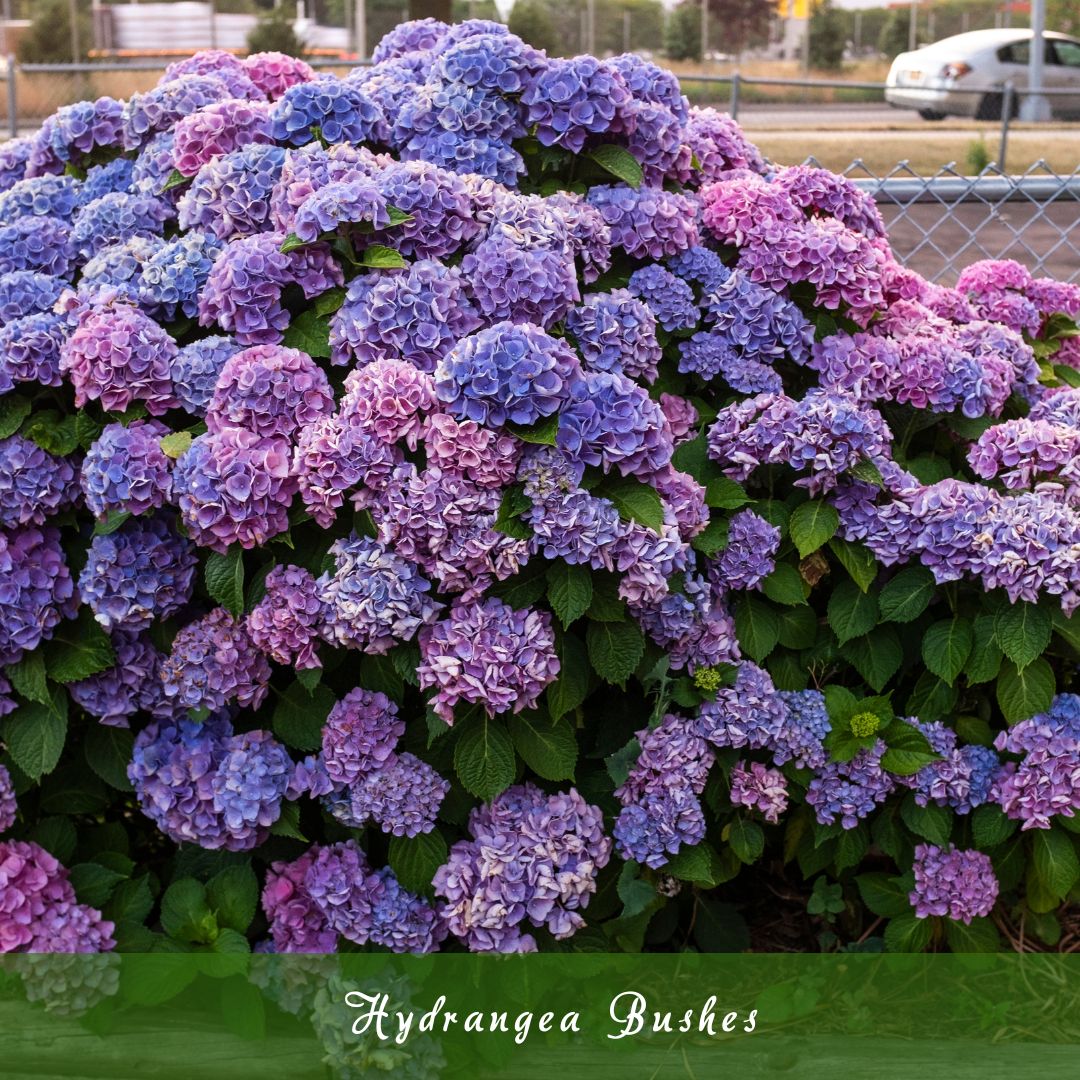
2. Azalea Bushes
Best For
Among the popular types of bushes for landscaping, azaleas are prized for their vibrant spring blooms and ability to thrive in shaded, woodland-like garden settings.
They thrive in woodland settings, where filtered light and rich soil mimic their natural habitat, making them perfect for shaded garden beds and naturalized landscapes.
Appearance
Azaleas are known for their vivid, trumpet-like flowers that come in a wide range of colours—pink, red, orange, purple, and white.
These blooms blanket the plant in a stunning display, often covering it so thoroughly that the green foliage seems hidden beneath the riot of spring colour.
Care
Azaleas prefer acidic, well-draining soil and thrive in locations with dappled or filtered sunlight. Azaleas grow best in USDA Zones 5 through 9.
Direct afternoon sun can scorch their delicate leaves, so partial shade is ideal. Keep the soil consistently moist, and add mulch to retain moisture and maintain the soil’s acidity for healthy growth.
3. Butterfly Bushes (Buddleia)
Best For
Butterfly bushes are pollinator magnets, drawing butterflies, bees, and even hummingbirds to your garden with their nectar-rich flowers.
Ideal for wildlife gardens or eco-friendly yards, they help support local ecosystems while adding vibrant life and movement to your outdoor space throughout the blooming season.
Appearance
This shrub showcases long, spiky flower clusters in stunning shades of purple, pink, white, or blue. The fragrant blossoms bloom throughout summer and into fall, creating a beautiful, scented focal point. Its graceful arching stems and airy structure add elegance and charm to any garden setting.
Care
Butterfly bushes grow well in full sun and well-drained soil, making them low-maintenance beauty shrubs. Their profusion of blossoms also draws pollinators. The best zones for butterfly bushes are USDA Zones 5 through 9.
Prune annually to encourage new growth and plentiful blooms. Their tough, resilient nature makes them an easy choice for gardeners seeking low-care beauty with big rewards.
Turn Your Passion for Nature Into Income
🌿 Whether you love gardening, caring for animals, or exploring holistic living,
You can share your knowledge online and earn from it.
Discover how nature lovers are growing their passions into meaningful, income-generating blogs. 👇
Low-Maintenance Bushes
For those who want beauty without much upkeep, these shrubs are ideal.
1. Spirea Bushes
Best For
Spirea is perfect for creating colourful, low-height borders or filling large areas with uniform beauty. It provides texture and charm to gardens without overpowering other plants or blocking views, and its compact growth habit and vivid blooms make it perfect for bulk planting.
Appearance
Spirea produces delicate clusters of tiny flowers, usually in soft pink or bright white. These blooms cover the shrub in spring or early summer, creating a frothy, cloud-like effect. Its fine-textured leaves complement the flowers, making spirea visually appealing throughout the growing season.
Care
A versatile option for many gardens, spiky plants are resilient and tolerant of a wide range of soil types and light levels. Spirea grows well in USDA Zones 3 through 8. To keep it healthy and encourage more blooms, prune spirea lightly after flowering. This simple maintenance keeps the shrub neat and promotes vigorous growth.
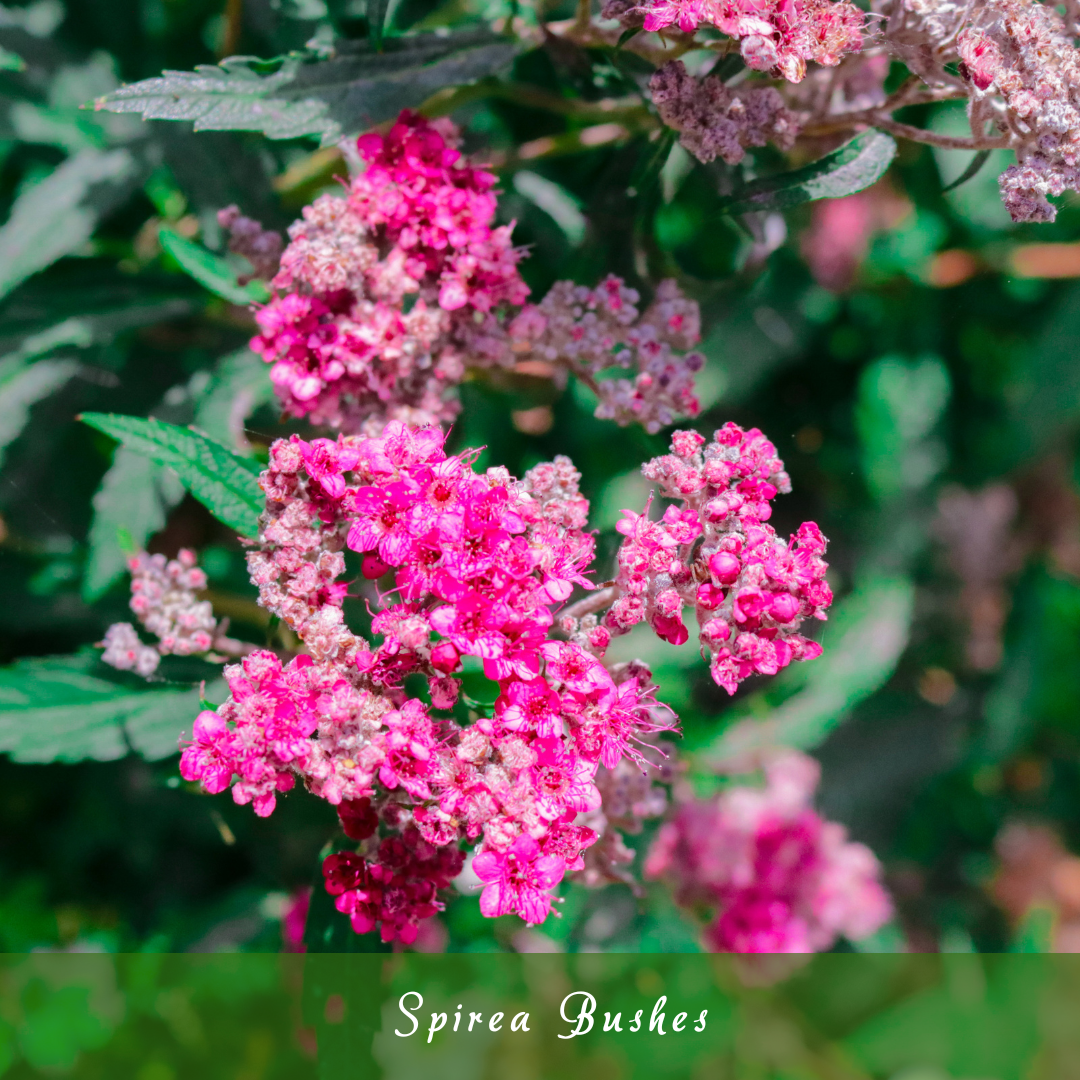
2. Barberry Shrubs (Berberis)
Best For
Barberry shrubs provide a striking colour contrast with their deep reddish-purple leaves, making them excellent for adding visual interest to gardens.
Their thorny branches also deter deer and other animals, helping protect your landscape from unwanted browsing while maintaining vibrant beauty year-round.
Appearance
Barberry features dense, sharp-thorned branches covered in rich reddish-purple leaves that hold their colour through much of the season.
The sharp thorns create a natural barrier, and in fall, some varieties produce bright berries, adding texture and seasonal interest to the shrub’s bold appearance.
Care
Barberry is a hardy shrub that tolerates poor soil, drought, and full sun, making it ideal for challenging garden spots. Barberry thrives in USDA Zones 4 through 8. It requires minimal maintenance and pruning, easily bouncing back from harsh weather and growing well with little attention, making it perfect for low-care landscapes.
3. Potentilla
Best For
Potentilla is a versatile addition to the types of bushes for landscaping, providing adequate ground cover, soil stabilization, and vibrant colour in challenging garden areas.
Its dense growth helps suppress weeds and stabilize soil, while adding a splash of colour. It’s an excellent choice for gardeners seeking both beauty and functionality in tough spots.
Appearance
Potentilla produces charming, delicate flowers in cheerful shades of yellow, white, or pink that bloom from late spring through summer.
These bright blooms stand out against their delicate green foliage, bringing continuous colour and interest to gardens, especially where low-maintenance flowering plants are desired.
Care
This shrub can withstand a variety of soil conditions, including rocky or poor soils, and grows best in full sun. Potentilla prefers well-drained ground and is hardy in USDA zones 2 through 7. It is ideal for low-maintenance gardening because it needs little pruning and watering.
Hedges And Privacy Bushes
If privacy is a priority, these dense bushes will shield your space stylishly.
1. Privet Bushes (Ligustrum)
Best For
Privet is widely used for creating dense, formal hedges that provide excellent privacy. Its rapid growth allows gardeners to establish boundaries or screens quickly.
The shrub’s thick foliage blocks unwanted views and defines garden spaces, making it a popular choice for neat, structured landscapes.
Appearance
Privet produces clusters of small, fragrant white flowers in late spring to early summer. These blooms add a delicate contrast to its dark green leaves.
The shrub’s vigorous growth and dense branching create a lush, whole appearance that holds its shape well throughout the season.
Care
To keep privet hedges looking tidy and well-formed, regular pruning is essential, especially during the growing season. It can tolerate a variety of soils, thrives in USDA zones 4 through 9, and likes full sun to light shade. Regular pruning promotes robust growth and lush foliage.
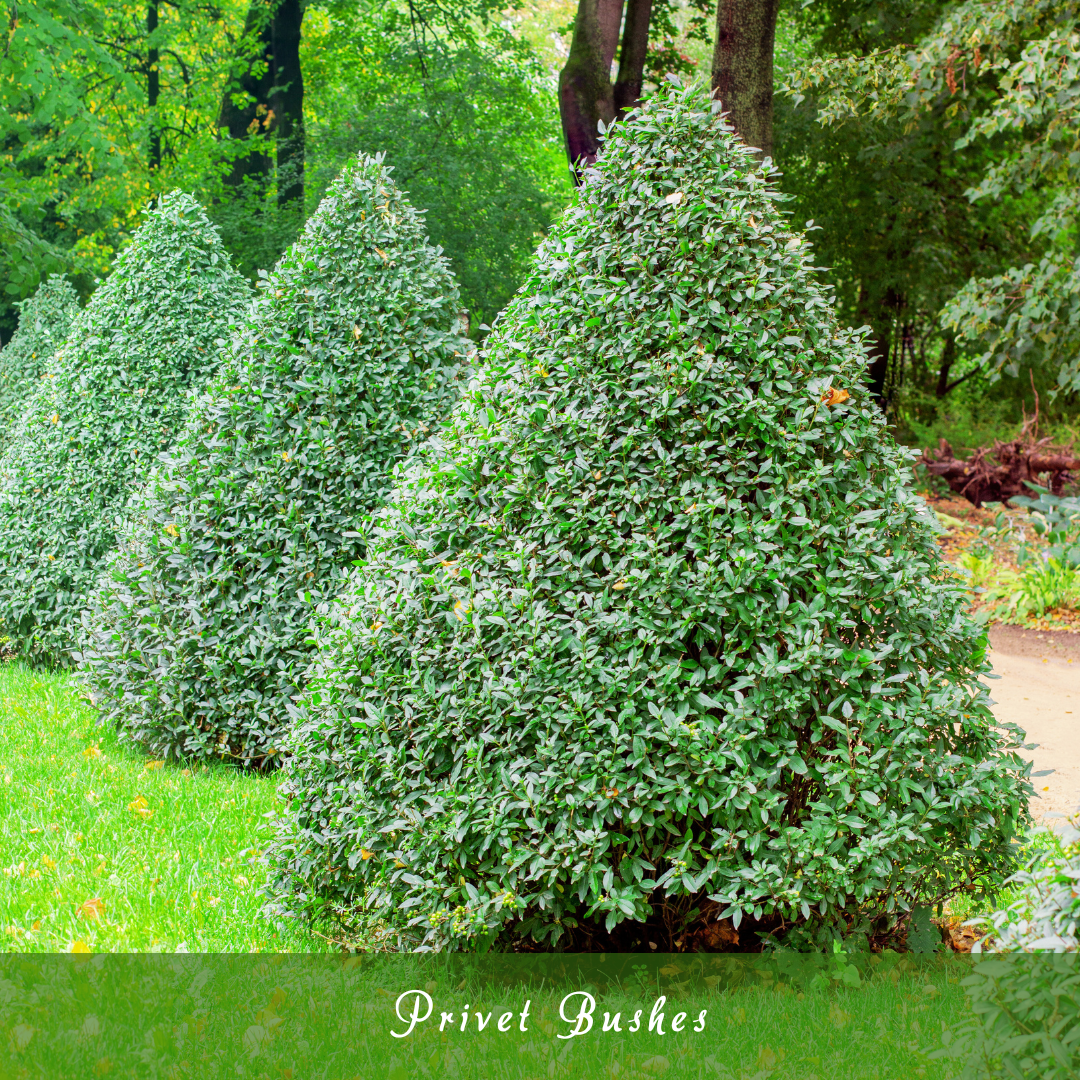
2. Arborvitae (Thuja)
Best For
Arborvitae is ideal for creating tall, dense windbreaks or privacy hedges. Its narrow, upright growth habit allows it to fit into tighter spaces while providing excellent screening.
This evergreen shrub effectively blocks wind and noise, making outdoor areas more comfortable and private throughout the year.
Appearance
Arborvitae features soft, scale-like green foliage arranged in flat sprays, giving it a lush, feathery appearance. Its tall, columnar shape creates a graceful vertical accent in landscapes. The rich colour remains vibrant year-round, adding consistent beauty to your garden or yard.
Care
This shrub prefers well-drained soil to prevent root rot and needs consistent watering, especially during dry spells or its first few years.
Proper care is essential for successful types of bushes for landscaping like arborvitae, which prefer well-drained soil, regular watering, and thrive best in USDA zones 3 through 7.
3. Viburnum Shrubs
Best For
Viburnum shrubs are versatile, providing year-round beauty while creating natural privacy screens. Their dense growth blocks views effectively, making them perfect for hedges or borders.
Throughout the seasons, they offer flowers, attractive berries, and colourful fall foliage, keeping your landscape vibrant and private all year long.
Appearance
Viburnums come in many varieties, each showcasing unique combinations of white or pink flowers, clusters of berries in red or black, and brilliant fall leaf colours ranging from orange to deep red. This diversity adds texture and multi-season interest to gardens and landscapes.
Care
Viburnums are hardy shrubs that adapt well to various soil types and light conditions, thriving in USDA zones 2 through 9. They require minimal maintenance and resist common pests and diseases, making them a reliable and low-stress option for gardeners seeking year-round appeal.
Colourful Foliage Bushes
These bushes shine even when they’re not in bloom thanks to their striking leaves.
1. Smoke Bushes (Cotinus)
Best For
Smoke bush is one of the standout types of bushes for landscaping, valued for its dramatic foliage and unique smoky flower clusters that create stunning focal points in any garden.
Its bold, colourful foliage and unique “smoky” flower clusters draw attention and add drama. Planted alone or in groups, it brings a striking contrast and texture to garden beds and borders.
Appearance
This shrub boasts rich purplish-red leaves that provide vibrant colour throughout the growing season. In summer, airy, cloud-like flower clusters emerge, resembling smoke or mist, giving the plant its distinctive name. Together, the foliage and flowers create a stunning, ethereal effect.
Care
Smoke bush is hardy and adaptable, thriving even in poor, well-drained soils. It prefers full sun to develop its best colour and flowering.
Once established, it needs little water and benefits from occasional pruning to keep its shape. In USDA zones 4–8, it is hardy.
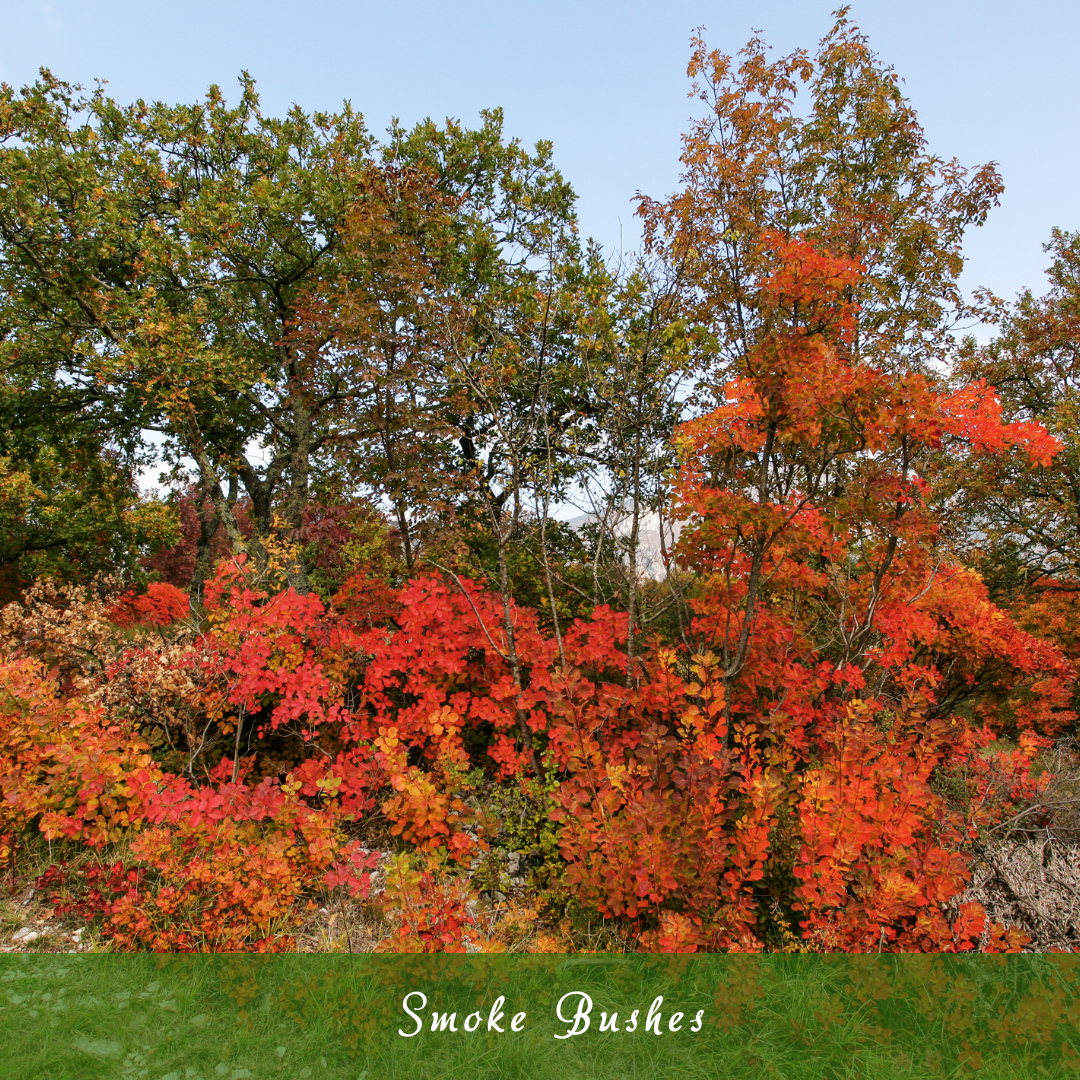
2. Ninebark (Physocarpus)
Best For
Ninebark is prized for adding unique texture to gardens. Its layered leaves and distinctive peeling bark create visual interest, making it an excellent choice for contrasting softer or smoother plants. It works well as a shrub border, background plant, or natural screen in diverse landscape designs.
Appearance
This shrub features striking reddish-purple leaves that provide rich colour throughout the growing season. Its bark naturally peels in thin layers, revealing lighter shades beneath, adding year-round texture and intrigue. The combination of other colours of your full foliage and textured bark enhances any garden’s depth and character.
Care
Ninebark is tough and adaptable, flourishing in full sun to partial shade. It needs little maintenance—just the occasional pruning to keep it looking nice—and can withstand a variety of soil types. Hardy in USDA zones 2 through 7, it’s an excellent low-maintenance choice for many gardens.
Conclusion
Choosing the right bushes can transform your landscape, adding beauty, privacy, and value to your outdoor space. Choosing from the many types of bushes for landscaping allows you to enhance your outdoor space with beauty, privacy, and year-round interest tailored to your garden’s style and climate.
Thoughtful selection and proper care ensure your landscape thrives year-round, creating a welcoming and attractive environment for you and your guests.
I trust you enjoyed this article on Best Types Of Bushes For Landscaping. Please stay tuned for more inspiring guides, helpful tips, and ideas to help you live closer to nature every day.
Take care!
— JeannetteZ
💬 Your Opinion Is Important To Me
Do you have thoughts, ideas, or questions? I’d love to hear from you. Please leave your comments below or email me directly at Jeannette@Close-To-Nature.org.
📚 More Nature-Inspired Reads
Explore more ways to connect with nature, nurture your pets, and live in harmony with the world around you 🌿

